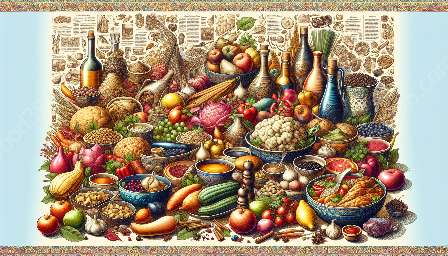The influence of trade and colonization on food diversity is a fascinating aspect of the evolution of food culture. This topic is intertwined with the influence of geography on food culture and the origin and evolution of food culture. As we delve into these interconnected aspects, we gain a deeper understanding of the complex interactions that have shaped the diverse cuisines we enjoy today.
Influence of Trade and Colonization on Food Diversity
Trade and colonization have played a pivotal role in shaping the food diversity we see today. The exchange of goods, ideas, and culinary traditions has led to the fusion of flavors and ingredients from different regions around the world. As merchants and explorers traversed the globe, they introduced new spices, crops, and cooking techniques to foreign lands, forever altering the culinary landscapes of the societies they encountered.
Impact on Food Diversity
One of the most significant impacts of trade and colonization on food diversity is the integration of foreign ingredients into local cuisines. For example, the Columbian Exchange, initiated by Christopher Columbus's voyages, resulted in the introduction of foods such as potatoes, tomatoes, and chili peppers to Europe, while also bringing products like coffee, sugarcane, and bananas to the Americas. This exchange had a profound and lasting effect on the dietary habits of people in both the Old and New Worlds, leading to the creation of new culinary traditions and the diversification of regional cuisines.
Culinary Adaptations and Innovations
Colonization brought not only the movement of crops and ingredients but also the transference of cooking methods and food preparation techniques. Indigenous cultures adapted to the new ingredients and cooking styles introduced by colonizers, creating hybrid dishes that reflected the merging of culinary traditions. This exchange of knowledge and practices further contributed to the rich tapestry of global food diversity, as flavors and cooking styles became intertwined and evolved over time.
Influence of Geography on Food Culture
Geography plays a pivotal role in shaping food culture. The climate, soil, and topography of a region directly influence the types of crops that can be cultivated, the availability of fresh produce, and the natural resources that are integral to local cuisines. Moreover, access to bodies of water and proximity to trade routes have historically determined the kinds of seafood and spices incorporated into regional dishes.
Regional Specialties and Dietary Practices
As a result of geographical variations, different regions develop their own culinary identities, with local specialties and dietary practices that reflect the abundance of certain ingredients and the cultural preferences of the inhabitants. For instance, the Mediterranean region is renowned for its emphasis on olive oil, fresh vegetables, and seafood due to its conducive climate and coastal location, while the use of spices and heat-tolerant crops dominates cuisines in tropical regions.
Food Preservation and Storage
Geography also influences the methods of food preservation and storage used by different cultures. In colder climates, communities traditionally relied on techniques such as smoking, drying, and fermenting to preserve food for long winter months, while regions with access to ample fruits and vegetables developed methods like pickling and canning to extend the shelf life of perishable produce.
Origin and Evolution of Food Culture
The origin and evolution of food culture are deeply intertwined with the historical movements of people, trade, and conquests that have shaped civilizations over millennia. Food has always been more than mere sustenance; it is a reflection of human experiences, traditions, and interactions, evolving alongside societies as they adapt to changing circumstances and encounters with new cultures.
Cultural Exchange and Fusion
The fusion of different culinary traditions through cultural exchange is a fundamental aspect of the origin and evolution of food culture. As people migrated, traded, or were conquered, they brought with them their unique culinary practices, leading to the melding of flavors, techniques, and ingredients across different regions. This blending of culinary heritage has resulted in the rich and diverse food cultures found around the world today.
Social and Historical Influences
Food culture is shaped not only by culinary traditions but also by social hierarchies, historical events, and economic factors. The availability of certain ingredients, the development of cooking technologies, and the emergence of global trade routes have all contributed to the evolution of food culture. Additionally, social customs, rituals, and religious beliefs have influenced the ways in which food is cultivated, prepared, and consumed, further adding layers of complexity to the history of food culture.


